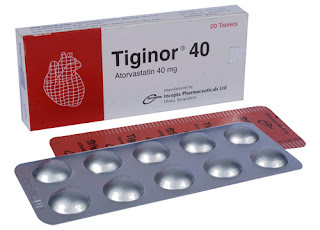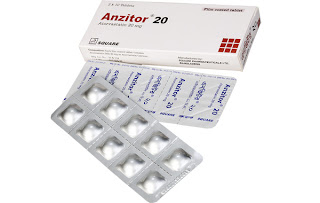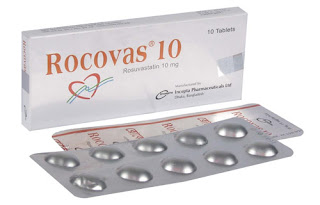Contents:01.Description
02.Classification
03.Mechanism of Action(Mode of Action)
04. Beneficial effects of Statins
05. Adverse effects of Statins
06. Clinical Studies
07. Available Brands
08. References
Description:
Statins, inhibitors of 3-hydroxy-3-methylglutaryl-coenzyme A (HMG CoA) reductase.The most efficient agents for reducing plasma cholesterol with good tolerance. Angiographic studies have demonstrated that these compounds-
- Reduce the progression of atherosclerosis
- Induce the regression of atherosclerosis
Statins reduce the endogenous cholesterol synthesis by competingly inhibiting the principal enzyme involved.In addition, statins show some benefits towards patients-
- Can Inhibit tumor cells growth;
- Enhance intracellular calcium mobilization;
- A reduction in the number of bone fractures;
- The reductiion of the number of major coronary events as well as general mortality in coronary patients.
Classification of Statins:
There are a few number of classification criteria for statins,they are-
- How they are obtained
- Liver metabolism
- Physico-chemical properties
- Specific activity
How they are obtained
Some of the statins ae obtained from fungal fermentation-
- Lovastatin
- Pravastatin
- Simvastatin
Some statins are obtained by lab synthesis-
- Fluvastatin
- Atorvastatin
- Cerivastatin (Withdrawn on August 8,2001 due to 31 patients died by acute renal failure caused by Rhabdomyolysis)
Liver Metabolism
- Follow the Citocrom P450 (CYP 3A4) Pathway-
- Lovastatin
- Simvastatin
- Atorvastatin
- Cerivastatin
- Follow CYP 2C9 Pathway-Fluvastatin
- Different Pathway- Pravastatin
Physico-Chemical Properties
- Hydrophobic in nature-
- Lovastatin
- Simvastatin
- Atorvastatin
- Cerivastatin
- Intermediate Characteristics- Fluvastatin
- Hydrophilic in nature - Pravastatin
Specific Activity
Active Compound (Acid Form)-
- Atorvastatin
- Cerivastatin
- Fluvastatin
- Pravastatin
Inactive forms (Lactone), which have to be enzymatically hydrolyzed to generate active forms-
- Lovastatin
- Simvastatin
Mechanism of Action:
Mechanism of action involves with categories:
- Mechanism Involving Lipids
- Mechanism Involving Intracellular Signaling Pathways
Mechanism Involving Lipids
- Inhibition of HMG CoA reductase
- Direct effects of HMG CoA reductase inhibition
- Reduction of LDL Susceptibility towards oxidation
- Inhibition of the expression of type A Scavenger receptor
Inhibition of HMG-CoA reductase
- Statins compete with the normal substrate in the enzymes active site
- Statins alter the conformation of the enzyme (HMG CoA reductase) when they bind to its active site.
- The inhibition of HMG CoA reductase determines the reduction of intracellular cholesterol.
- Statins inhibit hepatic synthesis of apolipoprotein B-100.(Which determine a reduction of synthesis and secretion of Triglyceride rich lipoproteins and an reduction of receptors production for apolipoproteins B/E.)
- This is the answer of the question- why Atorvastatin and Simvastatin are capable of reducing LDL in patients with homozigous family hypercholesterolemia?
- Statins have a modest effect on HDL increase.
Reduction of LDL Susceptibility towards oxidation
Four mechanisms were proposed to explain statins' antioxidant
properties-
One: Hypochlesterolemic
effect .......>Reduced lipoprotein CHOLESTEROL......>the reduced level of
oxidation substrate.
Two: The decrease of cell oxygen production by
inhibiting the generation of superoxide by macrophages.
Statins can also
prevent LDL oxidation by preserving the activity of the endogenous antioxidant
system, superoxide dimutase
Three: The binding of statins to phospholipids on the
surface of lipoproteins (Fluvastatin and Lovastatin bind to LDL phospholipids)
preventing the diffusion towards the lipoprotein core of free radicals
generated during oxidative stress.
Four: The potent antioxidative potential of the metabolites (i.e. Atorvastatin and Fluvastatin metabolites) also results in lipoproteins protection from oxidation.
Inhibition of the expression of type A Scavenger receptor
·
Inhibition of expression of type A scavenger receptor in THP-1
cells and in human monocytes.
·
This decreases the receptor-mediated degradation of oxidised LDL.
·
Statins reduce mRNA level and CD36 expression on the cell surface
as well as LDL binding to human U937 monocytes.
Mechanism Involving Intracellular Signaling Pathways
Prenylated proteins and their role in cellular signaling
Prenylated proteins:
A variety of proteins have covalently attached isoprenoid groups, mainly the C15 farnesyl and C20 geranygeranyl residues, that proteins are termed as Pronylated proteins.
Many pronylated proteins are associated with intracellular membranes and mutating their Cys prenylation sites blocks their membranes localization.
The hydrophobic prenyl group can act to anchor its attached protein to amembrane.
Prenylated protein may interact with specific membrane -bound receptor proteins and hence prenylation mediates protein-protein interaction.
Their role in cellular signaling:
The complex process of cell signaling is very important for intracellular communication.Many intracellular signaling molecules are prenylated proteins.
The specific surface on the cell surface are associated with trimeric G protein.The trimeric G protein has gamma sub unit allowing this signaling protein to be inserted in the cell membrane near specific memmbrane receptors and to receive extracellular signals,which are then transfered to the secondary signaling molecules in the cells.
The important role of the prenylated signaling molecules for the living cell is presented below-
Beneficial Effects of Statins:
1. Effects
on cholesterol esterification and its accumulation in macrophages
2. Effects
on endothelial cell function
3. Effects
on inflammatory process
4. Effects
on proliferation ,miration and apoptosis of arterial SMC(Smooth Muscle Cells)
5. Effects
on the stability of atherosclerotic plaque
6. Effects
on platelet activation
7. Effects
on coagulation process.
Adverse effects of Statin Therapy:
- Liver toxicity
- Muscle toxicity
- Hepatic dysfunction
- Renal insufficiency
- Hypothyroidism
- Serious infections.
Available Brands:
- Lipitor(Atorvastatin)-Pfizer
- Anzitor (Atorvastatin)- Square Pharmaceuticals Ltd.
- Lipicon (Atorvastatin)-Sk+f Bangladesh Limited.
- Tiginor (Atorvastatin)- Incepta Pharmaceuticals Ltd.
- Avas (Atorvastatin)-Opsonin Pharma Ltd.
- Ropitor (Rosuvastatin)-Opsonin Pharma Ltd.
- Rocovas (Rosuvastatin)- Incepta Pharmaceuticals Ltd.
- Rosuva (Rosuvastatin)-Square Pharmaceuticals Ltd.
References
1. Vaughan
C.J., Gotto A.M., Basson C.T., The evolving
role of statins in the management of atherosclerosis, J. Am. Coll. Cardiol., 35: 1-10, 2000
2. Hunninghake D.B., HMG-CoA reductase inhibitors, Curr. Opin. Lipidol., 3: 22-8, 1992
3. Bellosta S., Ferri N., Bernini F.,
Paoletti R., Corsini A., Non-lipid-related
effects of statins, Ann. Med., 32: 164-176, 2000
4. Meier C.R., Schlienger R.G.,
Kraenzlin M.E., Schlegel B., Jick H.,
HMG-CoA reductase inhibitors and the risk of fractures, JAMA, 283: 3205-3210, 2000
5. Blum C.B., Comparison of properties of four inhibitors of
3-hydroxy-3-methylglutaryl-coenzyme A reductase, Am. J. Cardiol., 73: 3D-11D, 1994
6. Lennernas H., Fager G., Pharmacodynamics and Pharmacokinetics of the HMG-CoA reductase
inhibitors: similarities and differences, Clin.
Pharmacokinet., 32: 403-425, 1997
7. Blumenthal RS., Statins: Effective antiatherosclerotic therapy, Am. Heart. J., 139: 577- 83, 2000
8. Corsini A., Bellosta S., Baetta R.,
Fumagalli R., Bernini F., New insights into
the pharmacodynamics and pharmacokinetic properties of statins, Pharmacol. Ther.,
84: 413-28, 1999
9. Sehayek E., Butbul E., Avner R., Enhanced cellular metabolism of very low density lipoprotein by
simvastatin: a novel mechanism of action of HMG-CoA reductase inhibitors, Eur. J. Clin. Invest., 24: 173-8, 1994
10. Stein E.A., Lane M., Laskarzewski
P., Comparison of statins in
hypertriglyceridemia, Am. J. Cardiol.,81: 66B-69B, 1998
11. Ginsberg H.N., Le N.A., Short M.P.,Ramakrishnan
R., Desnick R.J., Suppression of apolipoprotein B
production during treatment ofcholesteryl ester storage disease with
lovastatin:
implication for regulation of apolipoprotein B synthesis, J. Clin. Invest., 80: 1692-1697, 1987
12. Gaw A., Packard C.J., Murray E.F., Effects ofsimvastatin on apoB metabolism and LDL subfraction
distribution, Arterioscler. Thromb., 13:170-89, 1993
13. Marais A.D., Naumova R.P., Firth
J.C., Penny C.,Neuwirth C.K., Thompson G.R.,
Decreased production of low density lipoprotein by atorvastatin after apheresis
in homozygous familial hypercholesterolemia, J.
Lipid Res., 38: 2071-2078,1997
14. Raal F.J., Pilcher G.J.,
Illingworth D.R., Pappu A.S., Stein E.A., Laskarzewski P., Mitchel Y.B., Melino
M.R., Expanded dose simvastatin is effective in
homozygous familial hypercholesterolemia, Atherosclerosis, 135: 249- 256, 1997
15. Kostner G.M., Gavish D., Leopold
B., Bolzano K., Weintraub M.S., Breslow J.L.,
HMG-CoA reductase inhibitors lower LDL cholesterol without reducing Lp(a)
levels, Circulation, 80: 1313-1319, 1989
16. Aviram M., Hussein O., Rosenblat
M., Schlezinger S., Hayek T., Keidar S.,
Interactions of platelets, macrophages, and lipoproteins in hypercholesterolemia:
antiatherogenic effects of
HMG-CoA reductase inhibitor therapy, J. Cardiovasc. Pharmacol., 31: 39-45, 1998
17. Hoffman R., Brook G.J., Aviram M., Hypolipidemic drugs reduce lipoprotein susceptibility to undergo
lipid peroxidation: in vitro and ex vivo studies, Atherosclerosis, 93: 105-13, 1992
18. Wagner A.H., Kohler T., Ruckschloss
U., Just I., Hecker M., Improvement of
nitric oxide-dependent vasodilatation by HMG-CoA reductase inhibitors through
attenuation of endothelial superoxide anion formation, Arterioscler. Thromb. Vasc. Biol., 20: 61- 9, 2000
19. Chen L., Haught W.H., Yang B., Preservation of endogenous antioxidant activity and inhibition
of lipid peroxidation as common mechanisms of antiatherosclerotic effects of
vitamin E, lovastatin and amlodipine, J.
Am. Coll. Cardiol., 30: 569-75, 1997
20. Hrboticky N., Draude G.,
Hapfelmeier G., Lorenz R., Weber P.C.,
Lovastatin decreases the receptormediated degradation of acetylated and
oxidized LDLs in human blood monocytes during early stageof differentiation
into macrophages, Arterioscler. Throm. Vasc. Biol., 19: 1267-75, 1999
21. Pietsch A., Erl W., Lorenz R.L., Lovastatin reduces the expression of the combined adhesion and
scavenger receptor CD36 in human monocytic cells, Biochem. Pharmacol.,
52: 433, 1996
22. Voet D., Voet J.G., Lipids and membranes. In: John Wiley & Sons, Inc., eds.,
Biochemistry, SecondEdition, USA, 1995, pp. 315-316
23. Bernini F., Didoni G., Bonfadini
G., Bellosta S., Fumagalli R.,
Requirement for mevalonate in acetylated LDL induction of cholesterol esterification
in macrophages, Atherosclerosis, 104:
19-26, 1993
24. Bernini F., Scurati N., Bonfadini
G., Fumagalli R., HMG-CoA reductase inhibitors reduce
acetyl LDL endocytosis in mouse peritoneal macrophages, Arterioscler. Thromb. Vasc. Biol., 15: 1352-8, 1995
25. Laufs U., Fata V.L., Plutzky J.,
Liao J.K., Upregulation of endothelial nitric oxide
synthase by HMG-CoA reductase inhibitors, Circulation, 97: 1129-1135, 1998
26. Simionescu M., Stancu C.,
Costache G., Sima A., Endothelial cell response to hyperlipemia:
activation- dysfunction- injury; the protective role of simvastatin, Gen. Pharm., 2001
(in press)
27. Endres M., Laufs U., Huang Z.,
Nakamura T., Huang P., Moskowitz M.A., Liao J.K., Stroke protection by 3-hydroxy-3-methylglutaryl (HMG)- CoA
reductase inhibitors mediated by endothelial nitric oxide synthase, Proc. Natl. Acad. Sci. USA, 95: 8880-8885, 1998
28. Ross R., Atherosclerosis - an inflammatory disease, N. Engl. J. Med. 340:115-26, 1999
29. Weber C., Erl W., Weber K.S.C.,
Weber P.C., HMG-CoA reductase inhibitors decrease
CD11b expression and CD11b-dependent adhesion of monocytes to endothelium and
reduce increased adhesiveness of monocytes isolated from patients with
hypercholesterolemia, J. Am. Coll. Cardiol., 30: 1212-7, 1997
















No comments:
Post a Comment